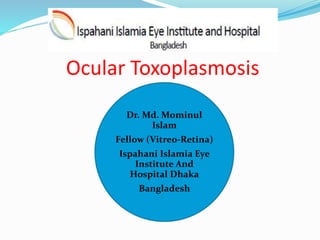
Oculartoxoplasmosis 140321025910-phpapp01
- 1. Ocular Toxoplasmosis Dr. Md. Mominul Islam Fellow (Vitreo-Retina) Ispahani Islamia Eye Institute And Hospital Dhaka Bangladesh
- 2. Introduction Common zoonosis Caused by Toxoplasma Gondii Life threatening disease (newborn and immnosuprresed patients) Asymptomatic in immuno competent patient Congenital or Acquired Both eye may affected
- 3. Epidemiology Represent with posterior uveitis 50-85% in Brazil 25% in USA Prevalence: (not well determind) 0.6-2% in USA 10-17.7% in Brazil
- 4. Transmission Beef Undercooked lamb , pork, chicken Environment contaminated by feces of infected cats family Organ transplantation Blood transfusion Water
- 5. Biology And Life Cycle Obligate , intracellular protozoan Both sexual and asexual reproduction Definitive host – Members of cat family Intermediate host- Hundreds of species including mammals, birds Host tissue - Muscle - Retina - Nervous tissue - Body fluid
- 6. Contd Three forms Oocyte Trachyzoite Bradyzoit (tissue cyst)
- 7. Genetics Type- I • Very virulent • Postnatal acquired ocular infection Type-II • Less virulent • Congenital infection and toxoplasmic encephalitis Type-III • Less virulent
- 8. Pathogenesis In immunocompetent patients is characterized histologically by Foci of granulomatous chorioretinal inflammation Coagulative necrosis of the retina with sharply demarcated borders Inflammatory changes can be widespread in the eye and involve choroid, iris, and trabecular meshwork
- 9. Contd In Immunosuppressed Have both tachyzoites and tissue cysts in areas of retinal necrosis and within retinal pigment epithelial cells. Parasites can occasionally be found in the iris, choroid, vitreous, and optic nerve
- 11. Ocular presentation Symptoms Floaters Blurring or loss of vision Sign (The hallmarks) necrotizing retinochoroiditis Satellite lesion adjacent to old hyperpigmented scars Vitreous inflammation Anterior uveitis Retinal vasculitis is also present (occationally)
- 13. Contd New or Acute lesion • Intensely white • Focal lesion overlying vitreous inflammatory haze (head light in the fog) • Acute anterior uveitis Healed lesion • Border become more defined • Hyperpigmented after several months • Large scar will have atrophic center (devoid of all choroidal retinal elements)
- 15. Investigation Serological test PCR
- 16. Differential Diagnosis Infectious: Rubella Cytomegalovirus Syphilis Herpes simplex Tuberculosis Toxocariasis
- 17. Contd Non-infectious: Retinal and choroidal coloboma Retinoblastoma, Retinopathy of prematurity Gyrate atrophy Retinal vascular membrane Serpiginous choroidopathy
- 18. Outcome And Complication Central vision will be lost Permanent loss of vision Sudden loss of vision.
- 19. Treatment and Prevention Available drugs do not eliminate tissue cysts and cannot prevent chronic infection No treatment has proven to be superior or even more effective than no treatment Antitoxoplasmic agents and systemic steroids have never been studied in large clinical trials
- 20. Pyrimethamine: 75–100 mg loading dose given over 24 hours, followed by 25– 50 mg daily for 4–6 weeks depending on clinical response Sulfadizine: “Classic” therapy: 2.0–4.0 g loading dose initially, followed by 1.0 g given 4 times daily for 4–6 weeks, depending or clinical response The combination of pyrimethamine, sulfadiazine, and corticosteroids Prednisone: 40–60 mg daily for 2 to many weeks depending on clinical response; taper off before discontinuing pyrimethamine/sulfadiazine Folinic acid: 5.0 mg tablet, 2–3 times weekly during pyrimethamine therapy
- 21. Contd Other Drugs: Trimethoprim and sulfamethoxazole. Systemic or intraocular clindamycin The duration of treatment depends on the individual clinical picture Steroid treatment is often administered systemically and always associated with antitoxoplasmic drugs Local drops are used when anterior uveitis is present
- 22. Take Whom Massage Wrong concepts in ocular toxoplasmosis All cases congenital Must present as a “retinochoroiditis” Vertical transmission (pregnancy) only once in life Cats and meat are the only source No treatment to avoid recurrences All patients need antitoxoplasmic drugs for 4–6 weeks Recurrences are related only to local factors
- 23. Thank you
Notes de l'éditeur
- Posterior uveitis most commonly affected by toxo
- When fetus infected it is usually 85%
- Large scar will have atrophic center ( devoid of all choroidal retinal elements) underlying sclera gives the lesion its white center.
- 1.retinal necrosis, uveitis, and its complications 2. if lesions affect the fovea, maculopapillary bundle, or optic disc 3. Other reported complications include macular edema, retinal neovascularization, vascular occlusion and vitreoretinal lesions such as vitreous hemorrhage and epiretinal membranes. Subretinal neovascular membranes may be a cause of 4. Rhegmatogenous and tractional retinal detachments may occur as well as secondary glaucoma and cataracts
- There are many questions surrounding the treatment of ocular toxoplasmosis
- probably is equally effective and has fewer side-effects and better patient compliance.It may be considered, however, as having a higher risk to cause severe allergic reactions because of the long life of sulfamethoxazole.[45